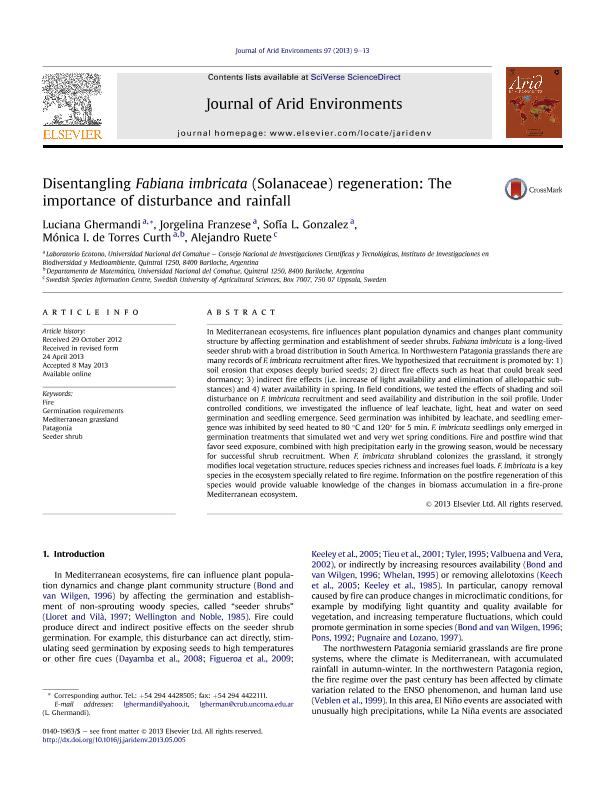Mostrar el registro sencillo del ítem
dc.contributor.author
Ghermandi, Luciana

dc.contributor.author
Franzese, Jorgelina

dc.contributor.author
Gonzalez, Sofia Laura

dc.contributor.author
de Torres Curth, Mónica
dc.contributor.author
Ruete, Alejandro
dc.date.available
2016-07-22T19:51:51Z
dc.date.issued
2013-06
dc.identifier.citation
Ghermandi, Luciana; Franzese, Jorgelina; Gonzalez, Sofia Laura; de Torres Curth, Mónica; Ruete, Alejandro; Disentangling Fabiana imbricata (Solanaceae) regeneration: the importance of disturbance and rainfall; Elsevier; Journal of Arid Environments; 97; 6-2013; 9-13
dc.identifier.issn
0140-1963
dc.identifier.uri
http://hdl.handle.net/11336/6652
dc.description.abstract
In Mediterranean ecosystems, fire influences plant population dynamics and changes plant communitystructure by affecting germination and establishment of seeder shrubs. Fabiana imbricata is a long-lived seeder shrub with a broad distribution in South America. In Northwestern Patagonia grasslands there are many records of F. imbricata recruitment after fires.We hypothesized that recruitment is promoted by: 1)soil erosion that exposes deeply buried seeds; 2) direct fire effects such as heat that could break seed dormancy; 3) indirect fire effects (i.e. increase of light availability and elimination of allelopathic substances)and 4) water availability in spring. In field conditions, we tested the effects of shading and soildisturbance on F. imbricata recruitment and seed availability and distribution in the soil profile. Under controlled conditions, we investigated the influence of leaf leachate, light, heat and water on seed germination and seedling emergence. Seed germination was inhibited by leachate, and seedling emergence was inhibited by seed heated to 80 C and 120 for 5 min. F. imbricata seedlings only emerged in germination treatments that simulated wet and very wet spring conditions. Fire and postfire wind that favor seed exposure, combined with high precipitation early in the growing season, would be necessary for successful shrub recruitment. When F. imbricata shrubland colonizes the grassland, it strongly modifies local vegetation structure, reduces species richness and increases fuel loads. F. imbricata is a key species in the ecosystem specially related to fire regime. Information on the postfire regeneration of this species would provide valuable knowledge of the changes in biomass accumulation in a fire-prone Mediterranean ecosystem.
dc.format
application/pdf
dc.language.iso
eng
dc.publisher
Elsevier

dc.rights
info:eu-repo/semantics/openAccess
dc.rights.uri
https://creativecommons.org/licenses/by-nc-nd/2.5/ar/
dc.subject
Fire
dc.subject
Germination Requirement
dc.subject
Mediterranean Grassland
dc.subject
Patagonia
dc.subject
Seeder Shrub
dc.subject.classification
Ecología

dc.subject.classification
Ciencias Biológicas

dc.subject.classification
CIENCIAS NATURALES Y EXACTAS

dc.title
Disentangling Fabiana imbricata (Solanaceae) regeneration: the importance of disturbance and rainfall
dc.type
info:eu-repo/semantics/article
dc.type
info:ar-repo/semantics/artículo
dc.type
info:eu-repo/semantics/publishedVersion
dc.date.updated
2016-07-22T18:52:47Z
dc.journal.volume
97
dc.journal.pagination
9-13
dc.journal.pais
Países Bajos

dc.journal.ciudad
Amsterdam
dc.description.fil
Fil: Ghermandi, Luciana. Consejo Nacional de Investigaciones Científicas y Técnicas. Centro Científico Tecnológico Patagonia Norte. Instituto de Investigación En Biodiversidad y Medioambiente; Argentina
dc.description.fil
Fil: Franzese, Jorgelina. Consejo Nacional de Investigaciones Científicas y Técnicas. Centro Científico Tecnológico Patagonia Norte. Instituto de Investigación En Biodiversidad y Medioambiente; Argentina
dc.description.fil
Fil: Gonzalez, Sofia Laura. Consejo Nacional de Investigaciones Científicas y Técnicas. Centro Científico Tecnológico Patagonia Norte. Instituto de Investigación En Biodiversidad y Medioambiente; Argentina
dc.description.fil
Fil: de Torres Curth, Mónica. Consejo Nacional de Investigaciones Científicas y Técnicas. Centro Científico Tecnológico Patagonia Norte. Instituto de Investigación En Biodiversidad y Medioambiente; Argentina
dc.description.fil
Fil: Ruete, Alejandro. Swedish University of Agricultural Sciences. Swedish Species Information Centre; Suecia
dc.journal.title
Journal of Arid Environments

dc.relation.alternativeid
info:eu-repo/semantics/altIdentifier/doi/http://dx.doi.org/10.1016/j.jaridenv.2013.05.005
dc.relation.alternativeid
info:eu-repo/semantics/altIdentifier/doi/10.1016/j.jaridenv.2013.05.005
dc.relation.alternativeid
info:eu-repo/semantics/altIdentifier/url/http://www.sciencedirect.com/science/article/pii/S0140196313000943
Archivos asociados
